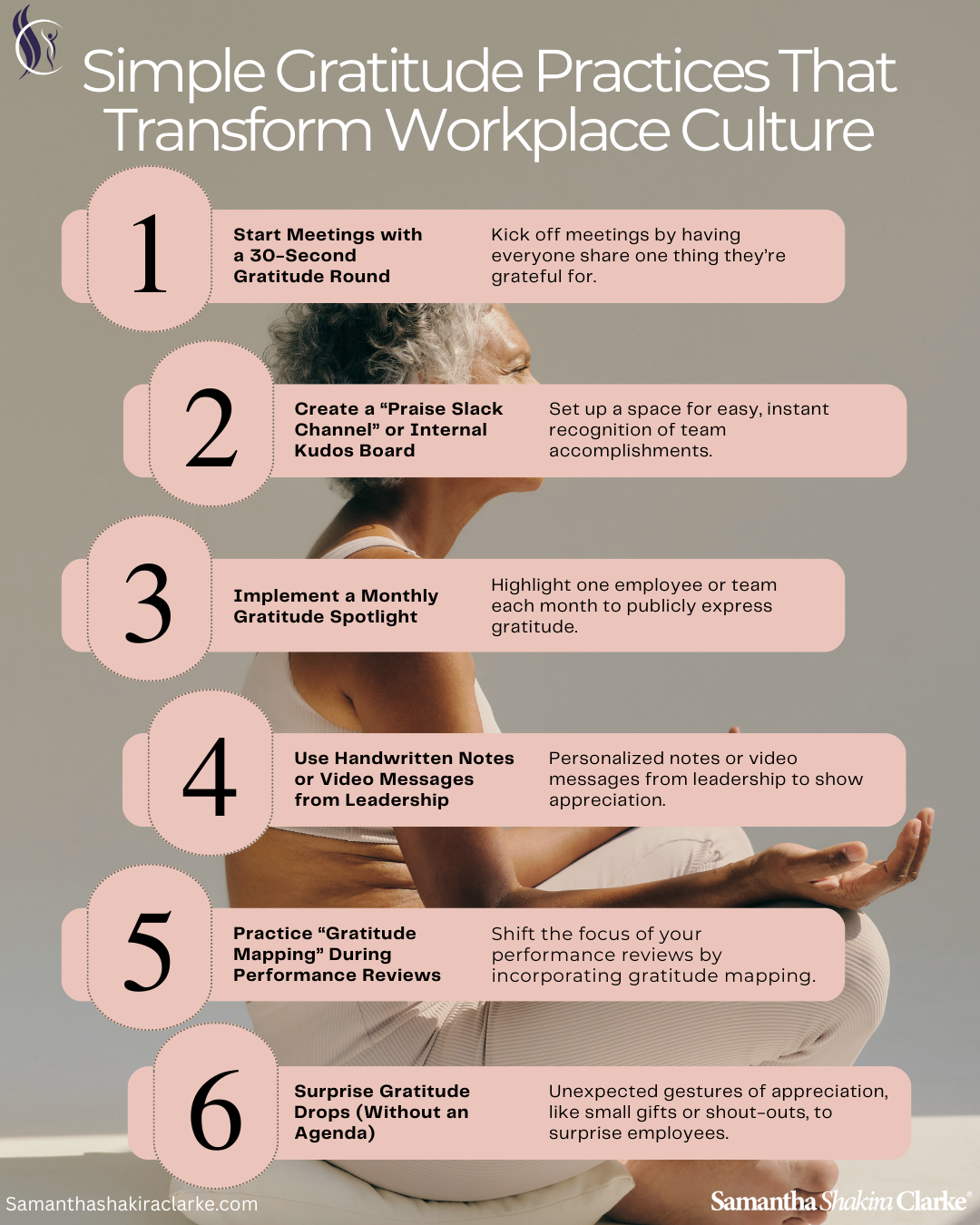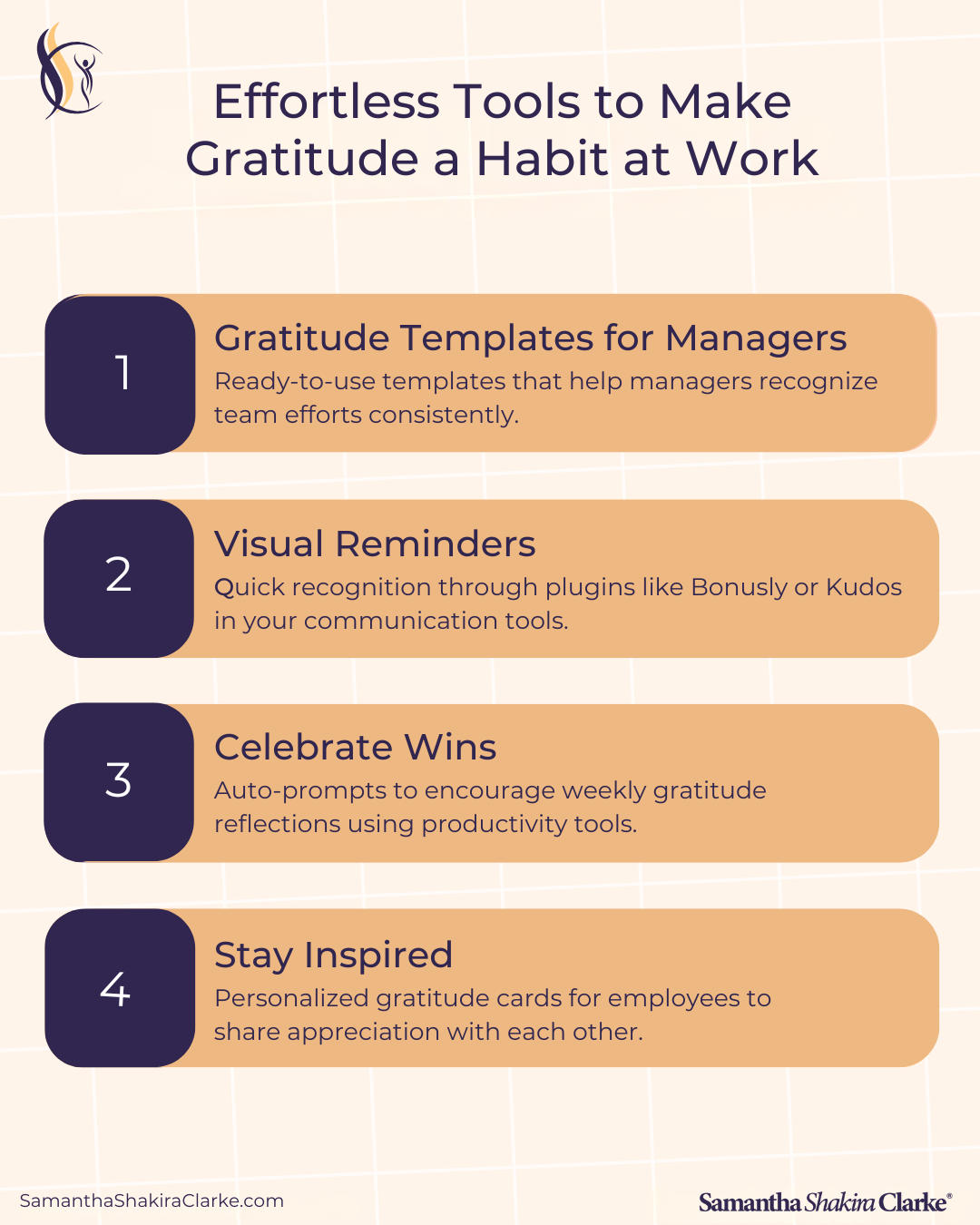 Book Now!
Book Now!Gratitude in the workplace is not just an optional practice; it’s a powerful tool that can transform company culture, creating an environment of trust, collaboration, and lasting engagement. When organizations actively practice gratitude, they build a foundation of trust, resilience, and stronger connections. If you’re looking to create a more connected and thriving work environment, this blog will show you how to get started. Ready to explore how gratitude can make a real impact? Let’s dive in and see how small changes can lead to big cultural shifts in your workplace.
If you're curious about how gratitude can elevate your team, contact SSC Corporate & Personal Wellness today, and let’s start making a difference!
Gratitude is often viewed as a feel-good sentiment, but its impact goes far beyond that. In fact, gratitude in the workplace is a culture builder. Studies show that when leaders model gratitude, they create an environment where employees feel valued, connected, and supported. This strengthens relationships and improves communication, two essential components of a thriving workplace culture.
The benefits of gratitude in the workplace are clear: employees are more engaged, teams work more cohesively, and job satisfaction skyrockets. Gratitude isn’t just a mood booster; it’s a proven strategy for long-term workplace success.
Many people believe that practicing gratitude is just a "soft skill" or that it’s not effective in high-stakes business environments. The truth is, these myths can prevent workplaces from unlocking the full potential of gratitude tools and practices. In fact, gratitude can be a powerful tool for building resilience, improving decision-making, and enhancing overall productivity. By debunking these myths and embracing gratitude as a strategic practice, you can foster a more engaged and high-performing workplace.
For more insight on how gratitude influences brain function and well-being, check out this article from the Greater Good Science Center: How Gratitude Shapes the Brain
You don’t need to overhaul your entire office culture to bring gratitude to life. Start small with these easy-to-implement gratitude tips: Whether you’re looking to improve team morale, enhance communication, or simply create a more positive work environment, these practices can fit seamlessly into your daily routines. The goal is to make gratitude an accessible and consistent part of your workplace, so that it becomes second nature for everyone.

1. Start Meetings with a 30-Second Gratitude Round
Kick of meetings by having everyone share one thing they're grateful for.
Encourage your team to share one thing they’re grateful for at the beginning of each meeting. It sets a positive tone and reminds everyone of the good that’s present, even during stressful times.
2. Create a “Praise Slack Channel” or Internal Kudos Board
A simple, low-effort way to spread gratitude is by setting up a digital space for recognizing team accomplishments. Whether it’s a Slack channel or an internal board, this tool can be a quick way to boost morale.
3. Implement a Monthly Gratitude Spotlight
Once a month, highlight one employee or team and publicly express gratitude for their contributions. It shows appreciation and helps others feel recognized, too.
4. Use Handwritten Notes or Video Messages from Leadership
Nothing beats the personal touch of a handwritten note or a short video message from a leader expressing genuine thanks. These gestures carry a lot of weight.
5. Practice “Gratitude Mapping” During Performance Reviews
Shift the focus of your performance reviews by incorporating gratitude mapping. This approach helps both managers and employees identify areas of growth while celebrating what’s working well.
6. Surprise Gratitude Drops (Without an Agenda)
Occasionally, surprise your employees with unexpected gestures of appreciation, a small gift, a coffee, or a quick shout-out. These “gratitude drops” show that you care without any strings attached.
7. Train Managers to Recognize and Reflect, Not Just Reward
Managers should focus on recognizing effort and growth, not just rewarding outcomes. This type of recognition fosters a culture where employees feel genuinely valued for their progress. By training managers to celebrate both small wins and personal development, you create an environment that encourages continued engagement and growth.
Gratitude doesn’t have to be time-consuming or complicated. Here are some gratitude tools to make practicing appreciation a breeze: From simple digital tools to creative low-effort practices, these tools help embed gratitude seamlessly into daily routines. The key is consistency. By integrating these tools, you ensure that gratitude becomes part of your organizational DNA without overwhelming your team or adding extra stress to their workload.

Provide your managers with easy-to-use templates to guide them in acknowledging their team’s efforts. This can make recognition consistent and scalable.
If your team uses tools like Slack or Teams, integrate plugins that allow quick recognition, like Bonusly or Kudos.
Use software tools like Notion or Lattice to send weekly auto-prompts that encourage employees to reflect on what they’re grateful for.
If you prefer the personal touch, consider printed or digital gratitude cards that employees can give to each other. It’s a tangible way to express appreciation.
For gratitude to truly have an impact, it needs to be part of the day-to-day culture, not just a temporary campaign. Incorporate small gratitude practices into regular routines, and encourage managers to make them part of team dynamics. This way, gratitude becomes a sustainable part of the workplace environment, not just an occasional focus. Regularly highlight moments where gratitude has been expressed and make those examples visible to the entire team. By making gratitude a consistent practice and publicly reinforcing it, you create a ripple effect that encourages everyone to adopt it as part of their daily interactions.
It’s important to track how gratitude is impacting your workplace. Tools like employee satisfaction surveys or productivity metrics can show how gratitude in the workplace translates into tangible benefits. Make sure to review these regularly to assess how your gratitude practices are influencing culture. Additionally, consider conducting periodic check-ins with employees to gather feedback on the effectiveness of your gratitude initiatives. This will help ensure that your practices are resonating and evolving with your team’s needs.
Gratitude in the workplace is not just a feel-good practice; it’s a transformative tool that builds a culture of appreciation, trust, and collaboration. When practiced consistently, gratitude can elevate your team's morale, improve productivity, and create an environment where everyone feels valued. By implementing some of these gratitude tips and integrating gratitude into your daily work life, you’ll be fostering a happier, more resilient team. Remember, the benefits of gratitude in the workplace are endless, and it’s never too late to start.
If you're ready to explore how gratitude can elevate your workplace culture, we’d love to help you get started. Reach out to us at team@samanthashakiraclarke.com or schedule a discovery call to learn more about creating a culture of gratitude in your organization. Together, we can unlock the full potential of your team.
To dive deeper into integrating wellness into your workplace, explore our blog on How to Incorporate Yoga into Your Corporate Wellness Program.